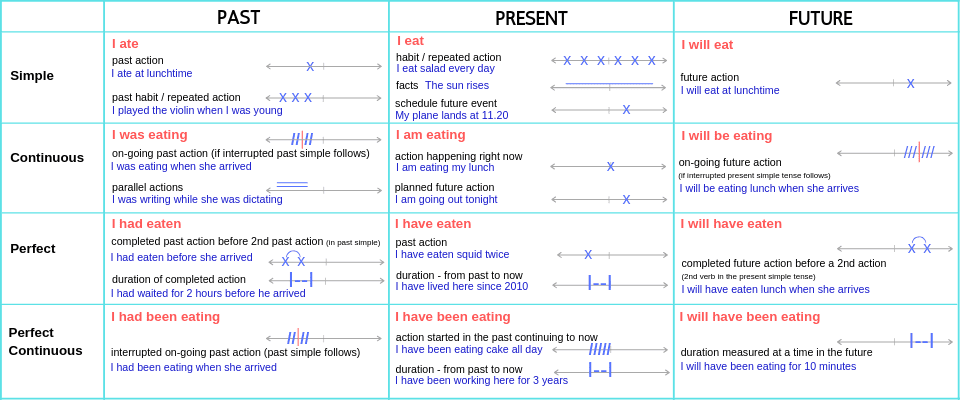Verb Tense Timelines

Verbs express an action or state and verb tense timelines help us understand how to use verbs correctly to indicate when the action took place.
In English, verbs are made up of 2 parts:
tense + aspect
As well as different tenses, verbs are categorised to indicate their form and uses.
Transitive Verbs
Intransitive Verbs
Linking Verbs
Auxiliary Verbs
Modal Verbs
Phrasal Verbs
First let’s look at tense and aspect.
TENSE
Tense tells the time period that the action happens in:
– happening now (present)
– happened already (past)
– will happen later (future)
So English has 3 main tenses:
– present
– past
– future*
Lucy is eating her sandwich. (present)
Lucy was eating her sandwich. (past)
Lucy will be eating her sandwich. (future)
ASPECT
Aspect tells how the action of the verb unfolds in relation to time, for example:
– some actions happen only once, some actions are repeated
– some actions last a short period of time, some actions extend for longer periods
There are 4 aspects
SIMPLE
single action
habit or repeated actions
CONTINUOUS (PROGRESSIVE)
ongoing or incomplete actions
one moment in time
to be + main verb ending +ing
PERFECT
completed actions
connects two points in time – something happened before something else happened
to have + main verb ending +ed or irregular
PERFECT CONTINUOUS (PERFECT PROGRESSIVE)
connects two points in time (like Perfect)
expresses that an action is incomplete (like Progressive/Continuous)
to have + been + main verb ending +ing
So therefore in English there are 12 major tenses.
You can find detailed information on each one via the links:
Note
You may see more than one name for the same tense, for example:
Simple Present and Present Simple have the same forms
Progressive and Continuous have the same form – Past Progressive, Past Continuous, Continuous Past are the same
* some consider that the future is not strictly a tense in English see Wikipedia
| Tenses | Examples |
| Present Simple | She writes a letter every day. |
| Present Continuous | She is writing a letter. |
| Present Perfect | She has written a letter. |
| Present Perfect Continuous | She has been writing letters for 2 hours. |
| Past Simple | She wrote a letter. |
| Past Continuous | She was writing a letter when he called. |
| Past Perfect | She had written the letter by the time he called. |
| Past Perfect Continuous | She had been writing letters for 2 hours before he called. |
| Future Simple | She will write a letter later. |
| Future Continuous | She will be writing letters when he calls. |
| Future Perfect | She will have written many letters by the time he calls. |
| Future Perfect Continuous | She will have been writing letters for 2 hours by the time he calls. |
TRANSITIVE VERBS
A transitive verb needs a noun to receive the action of the verb, known as a direct object, in order to express a complete thought.
She is bringing – this is incomplete
She is bringing a cake.
If a direct object is not present, the meaning does not make sense, and the reader or listener will be left with questions like, what or who the information refers to.
Sam gave – this is incomplete – what did Sam give?
Sam gave a book to Sally.
He will sell – this is incomplete – what will he sell?
He will sell his car.
There are many transitive verbs. Some common ones include:
get
give
make
sell
take
INTRANSITIVE VERBS
An intransitive verb does not need a direct object to make sense.
He ran.
She sat.
LINKING VERBS
A linking verb don’t express action, as verbs usually do. They connect the subject and the rest of the sentence by describing the subject using an adjective or a noun.
She was sad.
He was hungry.
she/he are the subjects
sad/hungry are the adjectives
was is the linking verb
The chefs are all masters.
chefs is the subject
masters is a noun
are is the linking verb
AUXILIARY VERBS
These are also known as helping verbs and are used with a main verb to form some of the different tenses in English.
The most common auxiliary verbs are to be, to have, to do.
Chris was eating his lunch.
Do you go to the cinema often?
More details on Auxiliary Verbs
MODAL VERBS
Modal verbs are a form of auxiliary verbs.
They include can, could, will, would, shall, should, ought to, must, may might.
Modal verbs do not change form and are often used with the verb to have.
More details on Modal Verbs
PHRASAL VERBS
Phrasal verbs are made up of:
verb + preposition or adverb
This results in a new meaning that is different from that of the separate parts.
Examples include:
to take off
to work out
to spell out
to break up
to set off
to pull through
The plane is taking off late.
She works out at the new gym every lunchtime.
There are hundreds of phrasal verbs in English.
See also: Conditional Tenses